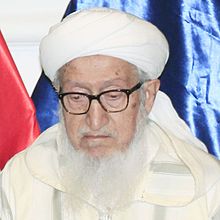Sufism in Afghanistan




Sufism is considered as an essential aspect of Islam in Afghanistan.[1] Most people are not followers of Sufism[2] but Sufis have a considerable influence on both urban and rural society.[1][3] Sufism has been part of the country for as long as 1300 years, so Afghanistan is recognised as the "Home of Sufi Saints".[1] Sufism was suppressed by the Taliban when they governed from 1996 to 2001, after which it was regaining its importance.[1]
Sufism has shaped Afghan society and politics for much of the country's history. Today, very few are aware of this legacy. Might the Sufis now provide an important contribution to the stability of the country?
— Marian Brehmer, 2015[4]
Influence
[edit]Sufism is tightly bound to the history of Afghanistan, as Afghan kings were traditionally crowned in the presence of a great Sufi master. The Sufis were also involved in revolts against many political rulers. In 1919, under King Amanullah, the Sufis felt their position in society under threat. Many Sufi and non-Sufi Muslim united to overthrow King Amanullah.[4]
Sufi rituals and practices
[edit]Qawwali, a devotional Sufi music, is sung over the country.[5] Other Sufi practices include zikr, construction of various Khanqahs to spread Islam.[5] The Naqshbandi tariqa is one of the most dominant Sufi orders in Afghanistan.[6][7] The Mujaddidiya branch of the Naqshbandi tariqa is said to influential to the present day. Pir Saifur Rahman was one of the notable Sufi of this order.[6] The other affiliates of the Naqshbandi order are Ansari, Dahbidi, Parsai, Juybari.[7] The other Sufi orders followed in Afghanistan are Qadriyya and Chishti Order.[1]
Mawlid is celebrated by Sufis in Afghanistan.[8] The various belongings of Muhammad such as Moo e Mubarak (Muhammad's Hair), Khirka Sharif, are sacred things for Sufis in Afghanistan, and they have built shrines around the belongings.[7]
Beliefs
[edit]People in Afghanistan regard Sufi shrines as places to unburden themselves, sharing their problems at the feet of Sufi saints, believing the saint can intercede on their behalf. It is a firm belief that prayer by a Sufi saint can eliminate poverty, cure illnesses, improve relations with loved ones and ease from various ills of life. When people become helpless after using all the possibilities in their hands, then they refer to Sufi saints. Sufi saints are considered as the representatives of Allah who can build their relationship with Allah and all their desires - through the saint - can be directly heard and fulfilled by Allah.[9]
Suppression of Sufi practices in Afghanistan
[edit]Sufism suffered during the Taliban rule of Afghanistan[5] from 1996 to 2001. It is said that many Sufis were tortured by the Taliban, and their musical instruments were destroyed. This led Sufis to remain underground for many years.[1]
On 15 March 2012, 11 Afghan Sufis were killed.[10] In 2018, around 50 religious scholars were the victim of suicide bombing during the Mawlid celebration in Afghanistan.[11][8][12]
Recognition
[edit]Former president of Afghanistan Sibghatullah Mojaddedi was a Sufi Shaikh.[13] [14] Sufis in Afghanistan are known for their miraculous powers.[1] Pilgrimage to Sufi shrine (Ziyarat) is recognised in all of Afghanistan.[1][2]
List of notable Afghani Sufis
[edit]Afghanistan is the birthplace of many Sufis, such as:[4]
- Hakim Sanai (Ghazni)
- Jami (Herat)
- Sheikh Mohammad Rohani
- Khwaja Abdullah Ansari
- Sibghatullah Mojaddedi
- Ahmed Gailani
- Abobaker Mojadidi
- Rumi[15]
- Ahmed Raza Khan Barelvi
References
[edit]- ^ a b c d e f g h Azami, Dawood (2011-02-23). "Sufism returns to Afghanistan after years of repression". BBC News. Retrieved 2020-06-26.
- ^ a b "Will The Taliban Listen To Afghanistan's Sufis?". RadioFreeEurope/RadioLiberty. Retrieved 2020-06-27.
- ^ "Afghanistan - Sufis". Country Studies. Retrieved 2020-06-26.
- ^ a b c Brehmer, Marian (2015-03-25). "Sufis in Afghanistan: The forgotten mystics of the Hindu Kush". Qantara.de - Dialogue with the Islamic World. Retrieved 2021-09-26.
- ^ a b c "Afghanistan: Sufi Mysticism Makes a Comeback in Kabul". Eurasianet. Retrieved 2020-06-30.
- ^ a b Lizzio, Ken (2003-06-01). "Embodying history: a Naqshbandi shaikh of Afghanistan". Central Asian Survey. 22 (2–3): 163–185. doi:10.1080/0263493032000157717. ISSN 0263-4937.
- ^ a b c McChesney, R. D. (2018-07-09). "Reliquary Sufism: Sacred Fiber in Afghanistan". Sufism in Central Asia: 191–237. doi:10.1163/9789004373075_008. ISBN 9789004373075.
- ^ a b "Condemning the attack in Kabul on Mawlid al-Nabi". www.mpac.org. Retrieved 2020-07-02.
- ^ Bari, Nasima. "Afghan women pilgrimage and their devoted beliefs". Khaama Press. Retrieved April 24, 2023.
- ^ "Killing of 11 Sufis at Afghan mosque mystifies authorities". AP NEWS. Retrieved 2020-06-27.
- ^ "At least 43 killed, 83 injured in suicide bombing at Mawlid gathering in Afghanistan's Kabul". Daily Sabah. Associated Press. 2018-11-20. Retrieved 2020-07-02.
- ^ "Suicide bomber kills over 50 at Eid-e-Miladunnabi event in Kabul". Dhaka Tribune. 2018-11-21. Retrieved 2020-07-02.
- ^ "From Sufi Sheikh to President: Historic mujahedin leader Mujaddedi passes away". Afghanistan Analysts Network - English (in Pashto). 2019-02-13. Retrieved 2020-06-29.
- ^ Malikyar, Helena. "Afghanistan: Sufi leaders add 'dignity' to elections". Aljazeera. Retrieved 2020-06-29.
- ^ Latifi, Ali M. (2015-03-08). "Afghanistan's ancient Sufi order shocked by deadly attack". Los Angeles Times. Retrieved 2020-07-02.


 French
French Deutsch
Deutsch